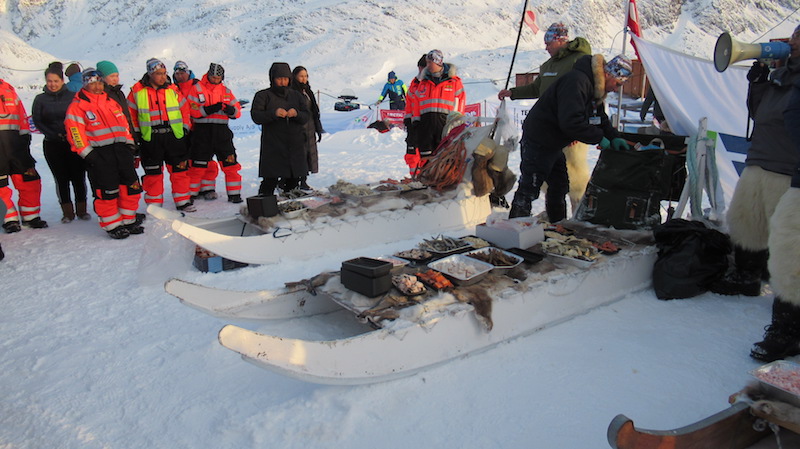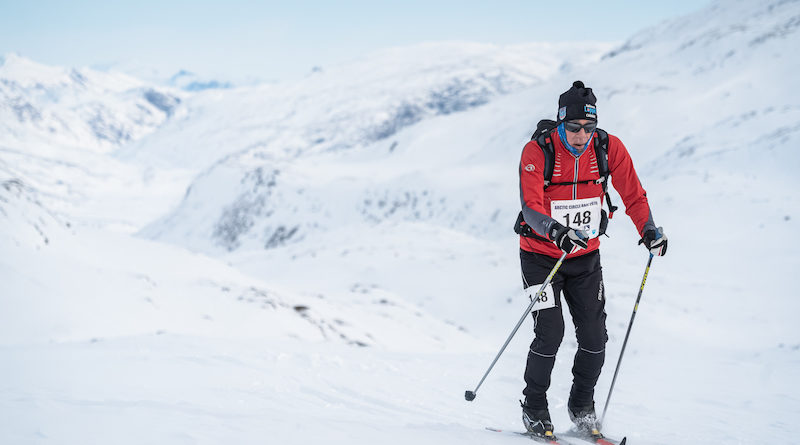The Arctic Ski Racer
Name: Dan Quinlan Age: 58 Lives in: Jericho Profession: Software manager for Collins Aerospace Family: Wife, Gudrun; children, Kaerstin (23) and Torsten (27) Primary sport: Nordic skiing
Dan Quinlan is one for epic feats. Last winter, for two of the three days of the Arctic Circle Race last winter, he was the top American contender. The ACR is referred to as the toughest cross-country race in the world. Back in 1982, Quinlan stayed closer to home when he created a 4.62K oval track in Williston and set the world record for the most mileage skied (290K) in a 24-hour period, a record he held for two years.
Why do the Arctic Circle Race?
I’m a bucket list person and I like the idea of a challenge. The ACR is way more than a race; it’s such an adventure. It’s a three-day 160-kilometer race from Arena to Camp in Greenland with 5,300 feet of climbing each day on a double-tracked trail. The problem is, it’s expensive and time-consuming because you have to fly five hours to Copenhagen and then four hours back to Greenland. Going into it, I had two goals: I wanted to complete it and I wanted to enjoy it because I only planned to do it once. Each day you can choose between the long or short routes. I signed up for the long, but I wasn’t in the best shape because I had a bit of a crash during the Canadian Ski Marathon where I busted my knee and my ankle. I’ve been following a six-month training schedule for years, based on the book Serious Training for Endurance Athletes. If I ever did it again, I’d do more hill training.
How did it go?
There were 160 racers. The first day we headed into the mountains and had a headwind for the first 25 kilometers which was fine because you really didn’t want to see what you were skiing into. I had an idea that it should take me about five hours but at that point I was only at checkpoint four [out of seven]. It took me six and a half hours and that blew me away. The whole “having fun” part was gone. It really is the world’s toughest ski race. You climb 3,500 meters in the first 20K. The first day I was the fastest of the nine Americans but since the having fun part was lacking, I hemmed and hawed and decided to do the short route on the second day. You report that and they scrawl over your bib like a scarlet letter or L for loser. Some people actually went home after the first day.
There was a white-out on the second day so they moved the starting time from 10:00 to 10:30 and then 11:00. Just like the first day, the track kept filling up with blowing snow. I remember that as I was herringboning up, the guy in front of me stumbled and I grabbed him to keep him from falling back on me and knocking us both down the mountain. On the third day it was still very windy although the temperature was good, so I went back to the long route and was the fastest American again but I’m not sure that should count for the whole race since I did the short route on day two. One guy from Maine did the full 160K and I only did 130K which was not an official distance. Day three was beautiful. That was the first time I could really see and that’s when I realized why it was so hard. You could finally see how hilly it was. There are no trees so there are no hard turns but there were still a few mandatory “skis off” sections.
I know you’ve done the Canadian Ski Marathon several times. How does this compare?
It’s very different from the Canadian marathon which follows groomed trails from Mont Tremblant and Lachute, Quebec. You only have to carry a survival kit with extra gloves, hat, dry pants, a whistle, sleeping bag and reflective blanket. You camp at the same place for two nights and they bring your food to camp. There are eight feed stations with water, sports drinks, chocolate, and bread but skiers had to bring their own cups and if you were caught littering, you would be disqualified. They have big warming tents for people to congregate and they have boiling water. You’re not expected to stay outside the whole time but you do sleep in your pup tent. I was in a three-man tent and although it was early April, the wind was just howling. If I had been the one to set the tent up, it would have blown over. The temperatures were in the single digits overnight and upper teens, low twenties during the day; mild according to the old-timers.
Can you tell us about the Canadian Ski Marathon?
That race has three different levels. If you ski the full two days at 80K a day you start out at the bronze level which allows you to sleep wherever you want. Then the next year, you can do the silver level where you carry 5kg. After that, you can qualify for the gold level where you have to carry what you need to survive the night under the stars. When I qualified for gold in 2012 after successfully doing the first two levels, I got what I call fat man skis. You really become a fast touring skier rather than a racer because you are carrying a sleeping bag, food and a change of clothes. I sweat a lot so I need extra clothing. Nobody carries a tent. Some people carry plastic that they hang from their ski poles but I built a bivy sac out of Tyvek. If you do the gold level five times you get your number retired and I really wanted that. My bib number (369) was retired in 2017.
Have you always been a skier?
I grew up in Bennington and started skiing when I was nine. I was Vermont State Champion in Nordic skiing (it was only classic in those days) in 1978 but I only skied one year at the University of Alaska where I studied electrical engineering. After college, I coached at Burlington High School for two years and South Burlington for one. I loved hanging around with the kids. I worked for several years in Germany and that’s when skate skiing came into vogue but I never really liked it and when I returned to Vermont, I went back to what I loved. I took a bit of a break from skiing when I had kids. We started geocaching and did that in every Vermont town and gore from 2005 to 2010. I created the Vermont 251 Plus 4 geocaching challenge [which challenges participants to find a geocached “treasure” in all 251 Vermont towns. ] I loved learning about many of the towns but the gores in the Northeast Kingdom were the most interesting. I’ve also climbed the 111 4,000-footers in the Northeast and biked from the Canadian border to Massachusetts on Route 100.
You’ve done a lot of distance skiing but in 1982 you did something completely different when you broke the 24-hour world record. Can you tell us about that?
I was coaching Burlington High School and looking for ways to raise money. The kids were supposed to collect pledges for every kilometer I skied. I discovered that the record had been set in Finland in 1977 and I wanted to break it. I set up a big loop at Catamount Family Center but there was too much climbing, so I settled on one that was 4.62K and Jim McCullough tracked it for me. The first time we set a date it snowed the night before so we had to wait for the temperature to go up and then down again. That fell during school break and the kids came out for the feeding and timing stations. I started at 4:30 p.m. and they got to stay up all night and play with walkie-talkies. It was the people who kept me going. I stopped twenty minutes shy of 24 hours when I realized I had the record at 290K but it was broken two years later.

Where else have you raced?
One of the things on my bucket list is doing the World Loppet. Loppet is the Norwegian word for ski marathon. Every skiing country has one. I’ve done the American Birkebeiner [in Wisconsin] and the Canadian Ski Marathon so I decided to race in Iceland after the ACR but it was horrible. The day before the race was cold and then it was raining and you have to show up with the right wax. They hold it late in the season and there was so little snow that they had to move it further up the mountain. They held it the first of May and you know, there’s this thing called climate change. People were passing me on the downhill and I’d catch up on the uphill but it was horrible. It turned into a vacation with a bit of skiing. This winter we’re going to Germany and France so I can add those marathons to the list.
Are you concerned about climate change hurting the ski industry?
Absolutely. Growing up in Bennington we would ski in early November and we didn’t need fake snow. By March I would be tired of skiing but that doesn’t happen now because sometimes it only starts snowing in January. I have passes at Rikert and Craftsbury because they make snow. At Craftsbury, so many teams train on their snow-making trail in the early season that if you stop for a moment you get run over. I think we have a first-hand understanding here in Vermont that climate change is real.
Featured Photo Caption: Peter Quinlan, skiing in the Arctic Circle Race. Photo by Aqqalu Inuuteq Dahl

